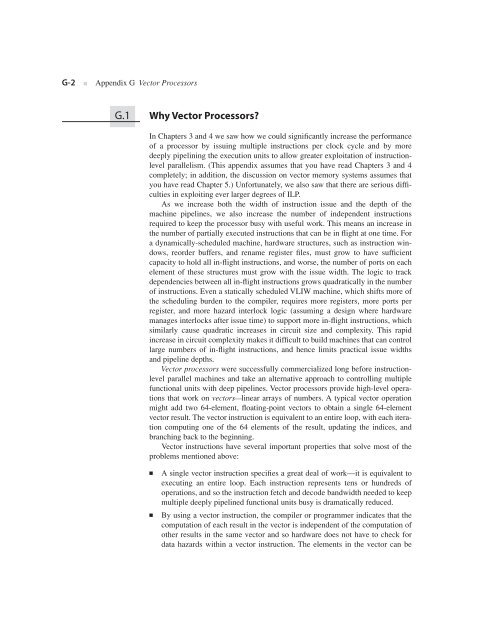Appendix G - Clemson University
Appendix G - Clemson University
Appendix G - Clemson University
You also want an ePaper? Increase the reach of your titles
YUMPU automatically turns print PDFs into web optimized ePapers that Google loves.
G-2<br />
■<br />
<strong>Appendix</strong> G<br />
Vector Processors<br />
G.1 Why Vector Processors?<br />
In Chapters 3 and 4 we saw how we could significantly increase the performance<br />
of a processor by issuing multiple instructions per clock cycle and by more<br />
deeply pipelining the execution units to allow greater exploitation of instructionlevel<br />
parallelism. (This appendix assumes that you have read Chapters 3 and 4<br />
completely; in addition, the discussion on vector memory systems assumes that<br />
you have read Chapter 5.) Unfortunately, we also saw that there are serious difficulties<br />
in exploiting ever larger degrees of ILP.<br />
As we increase both the width of instruction issue and the depth of the<br />
machine pipelines, we also increase the number of independent instructions<br />
required to keep the processor busy with useful work. This means an increase in<br />
the number of partially executed instructions that can be in flight at one time. For<br />
a dynamically-scheduled machine, hardware structures, such as instruction windows,<br />
reorder buffers, and rename register files, must grow to have sufficient<br />
capacity to hold all in-flight instructions, and worse, the number of ports on each<br />
element of these structures must grow with the issue width. The logic to track<br />
dependencies between all in-flight instructions grows quadratically in the number<br />
of instructions. Even a statically scheduled VLIW machine, which shifts more of<br />
the scheduling burden to the compiler, requires more registers, more ports per<br />
register, and more hazard interlock logic (assuming a design where hardware<br />
manages interlocks after issue time) to support more in-flight instructions, which<br />
similarly cause quadratic increases in circuit size and complexity. This rapid<br />
increase in circuit complexity makes it difficult to build machines that can control<br />
large numbers of in-flight instructions, and hence limits practical issue widths<br />
and pipeline depths.<br />
Vector processors were successfully commercialized long before instructionlevel<br />
parallel machines and take an alternative approach to controlling multiple<br />
functional units with deep pipelines. Vector processors provide high-level operations<br />
that work on vectors—<br />
linear arrays of numbers. A typical vector operation<br />
might add two 64-element, floating-point vectors to obtain a single 64-element<br />
vector result. The vector instruction is equivalent to an entire loop, with each iteration<br />
computing one of the 64 elements of the result, updating the indices, and<br />
branching back to the beginning.<br />
Vector instructions have several important properties that solve most of the<br />
problems mentioned above:<br />
■<br />
■<br />
A single vector instruction specifies a great deal of work—it is equivalent to<br />
executing an entire loop. Each instruction represents tens or hundreds of<br />
operations, and so the instruction fetch and decode bandwidth needed to keep<br />
multiple deeply pipelined functional units busy is dramatically reduced.<br />
By using a vector instruction, the compiler or programmer indicates that the<br />
computation of each result in the vector is independent of the computation of<br />
other results in the same vector and so hardware does not have to check for<br />
data hazards within a vector instruction. The elements in the vector can be

















